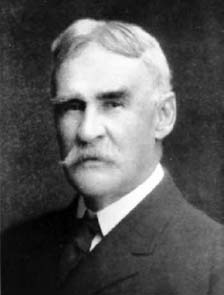The Battle of White Sulphur Springs (11 page)
Read The Battle of White Sulphur Springs Online
Authors: Eric J. Wittenberg

The intersection of the James River Turnpike and the Anthony's Creek Road, which was the center of the battlefield. The small house had a cannonball hole in it from a Union artillery shot.
West Virginia State Archives
.
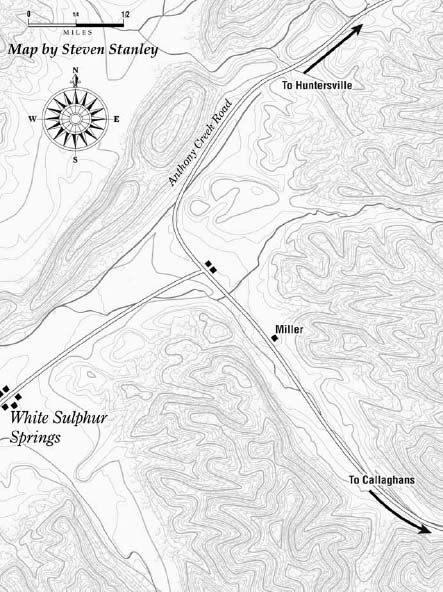
The White Sulphur Springs battlefield.
“What was the matter? Were we pursued or pursuing, or trying to head off the enemy in the other direction?” recounted Edgar. “We could only conjecture. One thing was plainâthere was great urgency governing the movements, for though sleepy and but little rested, our speed was increased and the steps were short.” He continued, “Couriers came and others went, but no changes were made either in the direction or speed of the march.”
193
One of Patton's infantrymen correctly observed, “If we had been one half hour later the Enemy would of passed on to Lewisburg and gotten away without a fight.”
194
After leaving the 23
rd
Battalion of Virginia Infantry and the 37
th
Battalion of Virginia Cavalry behind at the nearby Greenbrier River Bridge, Jones rode out to meet up with the rest of Patton's Brigade. Jones sent two of his staff officers, Adjutant Noyes Rand and Major George McKendree, to ride ahead while Jones and the rest of his staff rode about a mile to the Dry Creek Hotel. Charles W. Humphreys of the 26
th
Virginia was part of the advance guard, watching as the battalion marched by. Just then, a panicked Rand galloped back, crying out, “Clear the road; the Yankees are coming!” He reported that the blue-clad troopers had captured McKendree, and he “had gotten away by the skin of his teeth.” Noyes then dashed away as fast as his horse could carry him to report to Jones that the enemy was coming in force. “In about ten minutes the General and his staff came back riding a la Sheridan twenty miles away, minus the poetry,” remembered Humphreys.
195
What became the White Sulphur Springs battlefield is approached by a narrow gorge, traversed by two major thoroughfares, the James River and Kanawha Turnpike and the Anthony's Creek Road, which intersected with the turnpike about the middle of the valley. These two roads were nearly at right angles with each other. A small wood-frame house stood at the road intersection, and several other houses dotted the battlefield. The gorge opened into a gently undulating valley that was bounded on the right by a hill that was wooded at the top but cultivated as a cornfield at the bottom. The hill gently sloped toward Wade's Creek, which in turn was bounded by precipitous bluffs that were covered by scraggly cedars and other mountain growth. The terrain favored the defense and meant that this intersection could not be flanked; only a successful frontal attack would drive the defenders from the intersection. The town of White Sulphur Springs lay about a mile to the west, and a small settlement centered on the house and store of a prosperous local merchant named Henry Miller. This valley became the scene of the heavy fighting that would occur the next day.
196
The pieces were now all in place for the Battle of White Sulphur Springs. Would Patton be able to stop Averell from reaching Lewisburg and the law library?
4
The Battle Is Joined
At four o'clock on the morning of August 26, Brigadier General William W. Averell formed his Fourth Separate Brigade to move out in the direction of White Sulphur Springs. It proved to be a bright, beautiful summer day, ideal for fighting a battle.
197
The intrepid Captain Paul Freiherr von König led the way with the advance guard of two companies of the 2
nd
West Virginia and two companies of the 8
th
West Virginia. Next came the balance of the 2
nd
West Virginia, followed by the balance of the 8
th
West Virginia. Gibson's battalion was next in line in the column, followed by Ewing's battery, the 14
th
Pennsylvania Cavalry, with the 3
rd
West Virginia bringing up the rear of a column that stretched for four miles.
198
The Federals encountered two mountain ranges in the first ten miles of the march, slowing the pace of their advance significantly. “After passing the summit of the mountain we dashed down the ravine at a trot,” recounted a member of the 8
th
West Virginia.
199
Lieutenant Alexander J. Pentecost, the quartermaster of the 2
nd
West Virginia, rode with Captain Chatham T. Ewing, Averell's battery commander. While the two officers chatted about various subjects, they spotted a man on a gray horse descending a hill. As soon as the man spotted the advancing Union troopers, he turned tail, put spurs to his horse and tried to flee. Ewing and Pentecost galloped off in pursuit and soon overtook and captured the man. In reply to Ewing's questions, he admitted that he was a Confederate quartermaster officer and was out purchasing supplies. Ewing spotted something bulky in the man's pocket and asked what it was. “It is Confederate money,” the man replied, pulling out a large wad of bills, which Ewing promptly seized. The man asked for a receipt so he could account for the money, and Ewing replied, “This is our quartermaster and he will give you a receipt.” With that, Ewing wheeled and rode off, leaving Pentecost to deal with the man, who was handed over to the brigade's provost marshal.
200
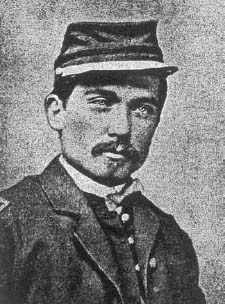
Lieutenant Alexander J. Pentecost, quartermaster, 2
nd
West Virginia Mounted Infantry.
Frank S. Reader
, History of the Fifth West Virginia Cavalry.
By 9:30 a.m., Averell and the main body had only covered thirteen miles. However, Baron von König and his advance guard had already arrived at Rocky Gap and had already faced stiff resistance from Patton's Virginians. The baron sent a note back to inform Averell that the enemy was in his front in force and that he needed reinforcements. Averell ordered a squadron of the 2
nd
West Virginia to advance at the trot, and he also dispatched a squadron of the 8
th
West Virginia to support them. A few minutes later, Averell heard Chapman's guns barking, announcing George Patton's “purpose of disputing our farther progress and indicated his strength.”
201
After an exhausting all-night march, Patton's advance guardâLieutenant Colonel George Edgar's 26
th
Battalion of Virginia Infantryâreached and then passed the intersection of the Anthony's Creek Road and the James River and Kanawha Turnpike just as Baron von König's advance elements began emerging from the Rocky Gap gorge. In short, the Virginia infantrymen got there just in the nick of time. Patton ordered Edgar to countermarch his men and form them in line of battle across the road, facing eastward, and to deploy a company of skirmishers to his left and front.
Edgar formed four companies on the left of the intersection of the two roads and sent Major Richard Woodram with the other four companies to the right, forming along the edge of the woods.
202
“To place the battalion in a defensive position on elevated ground on the side of the turnpike is the work of but five minutes, where with loaded arms it awaits developments,” recalled Edgar.
203
Patton also ordered Edgar to hold on until the rest of his brigade arrived, giving Edgar a stern task.
204
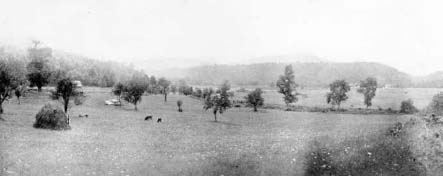
A view of the center of the battlefield. The road intersection where the Confederates built their barricade is in the center of the photograph.
West Virginia State Archives
.
Patton also sent one of his staff officers, Lieutenant J.W. Branham, on a reconnaissance into Averell's rear to find out how large a force was approaching. Branham dashed off and successfully completed the ride, reporting the results to Patton just as the Confederate infantry took position. The critical intelligence that Averell's entire brigade was advancing told Patton how he needed to deploy his troops to meet the threat.
205
Edgar's men used the few minutes available to them to cobble together a crude barricade across the road. The hastily built barricade was just strong enough to hold off the initial Union attacks and to deceive the Federals as to its strength, and Edgar's men stood long enough for the rest of Patton's Brigade to come up and deploy. “The enemy were strongly entrenched,” recorded a member of the 2
nd
West Virginia.
206
However, Patton had chosen the position wellâbecause of the high ground on either side, it could not be flanked, and if Averell were to drive the Confederates off, he would have to do so by frontal assaults.
207
Edgar had no idea how large of a force he faced that morning. He never realized that Averell had only thirteen hundred carbines in his brigade. Just a few days after the conclusion of the battle, Edgar wrote to the commandant of the Virginia Military Institute and stated his belief that “the enemy's force was not less than 4,000.”
208
Edgar, convinced he was badly outnumbered, nevertheless vowed to execute Patton's orders.
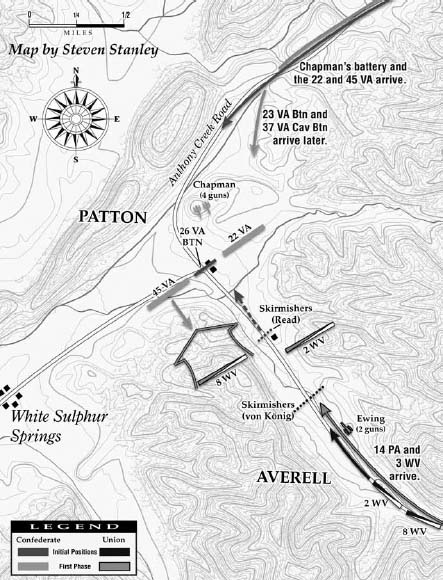
The battle opens, morning, August 26, 1863.
The company of skirmishers, under command of Captain Edmund S. Read, advanced to the house and store of Henry Miller, situated about one hundred yards in front of Edgar's left. Read and his soldiers opened the battle by unloosing a volley at von König's column that halted the German baron and his two companies in their steps and drove them back.
209
However, the Federals “soon reappeared in skirmish line and we began the practice of taking pop shots at them,” recalled a member of Read's Company B of the 26
th
Battalion. “The situation was looking quite stormy for us when Chapman's Battery broke loose behind us and sent our foes scampering back for a while.”
210
